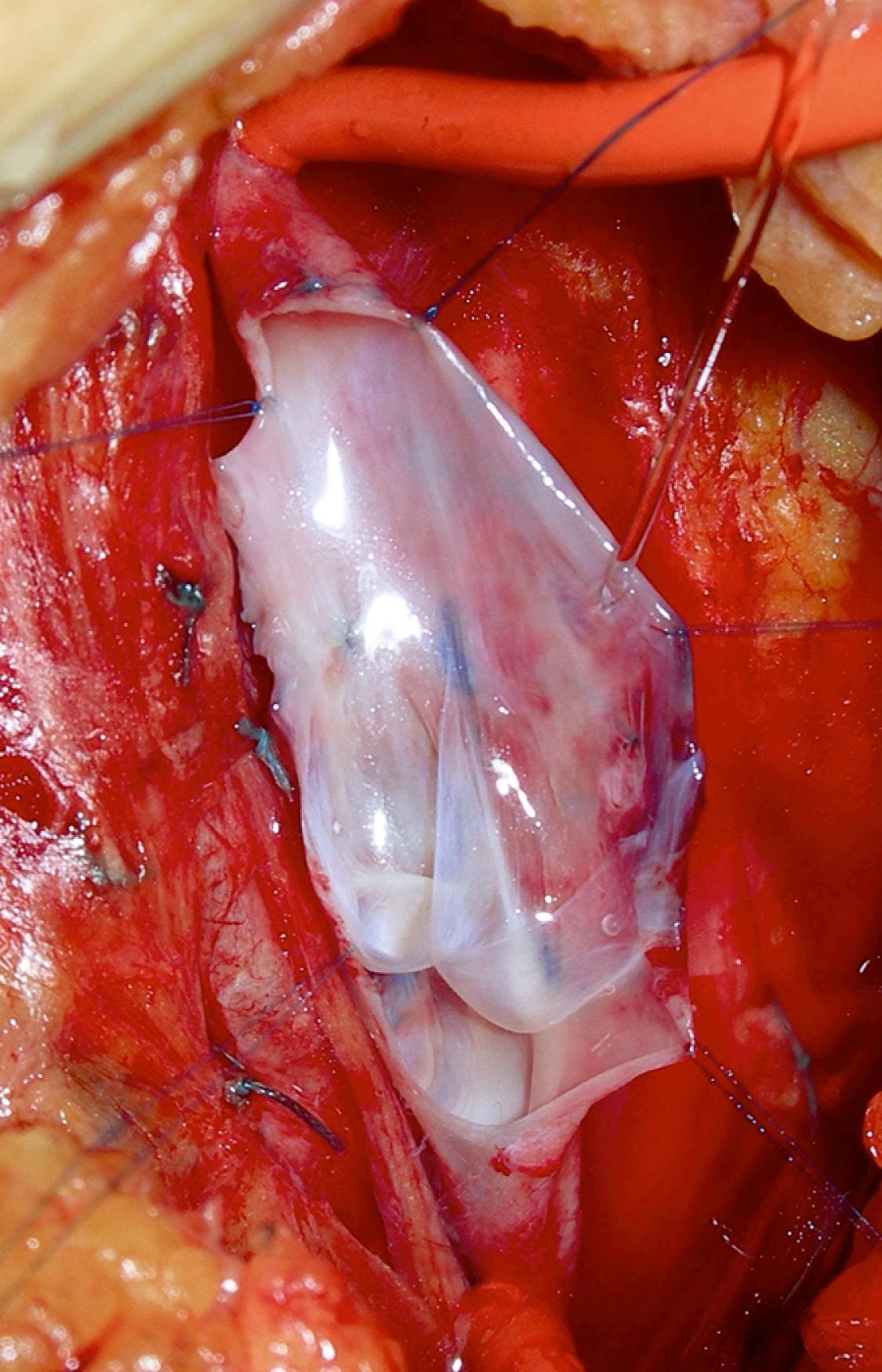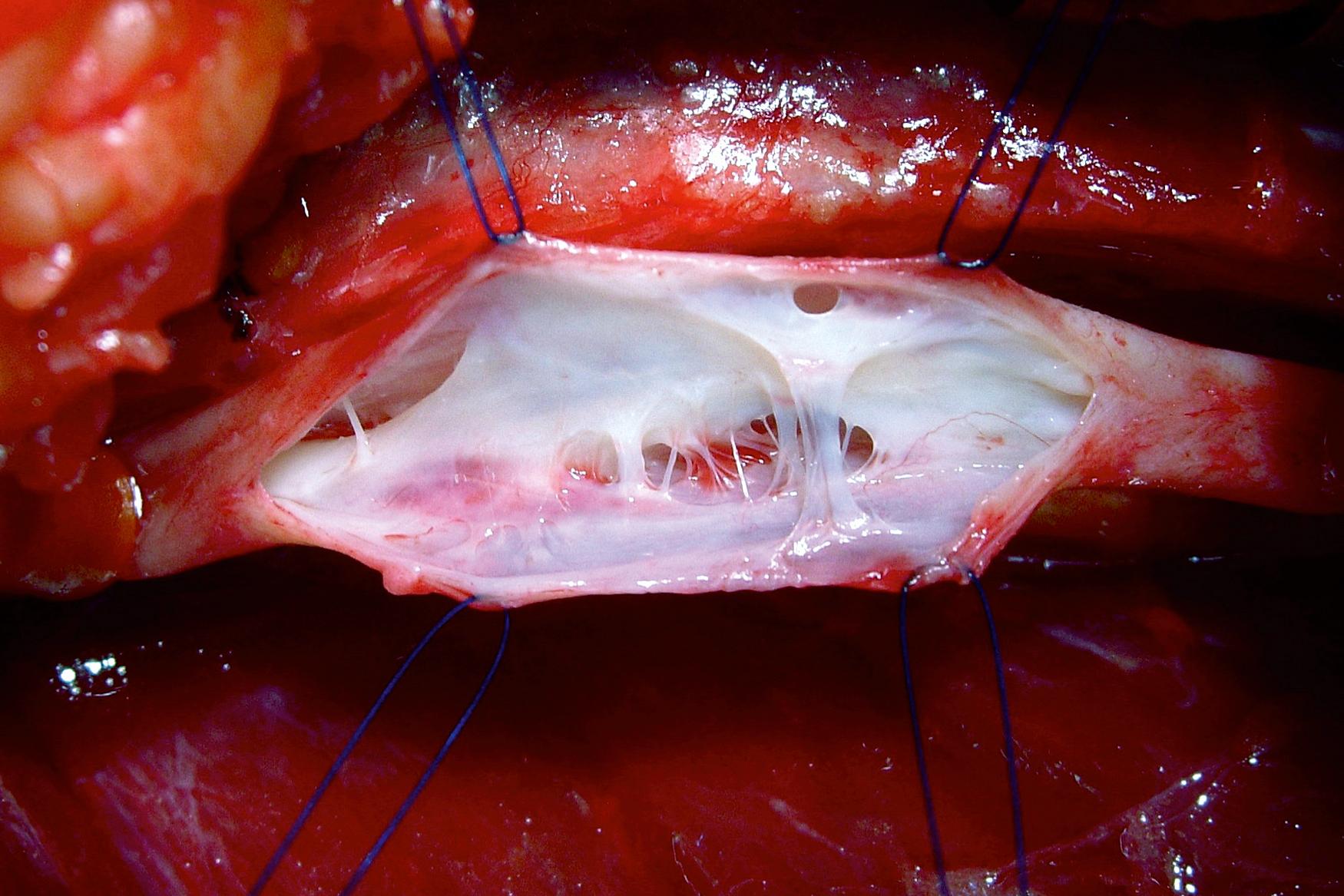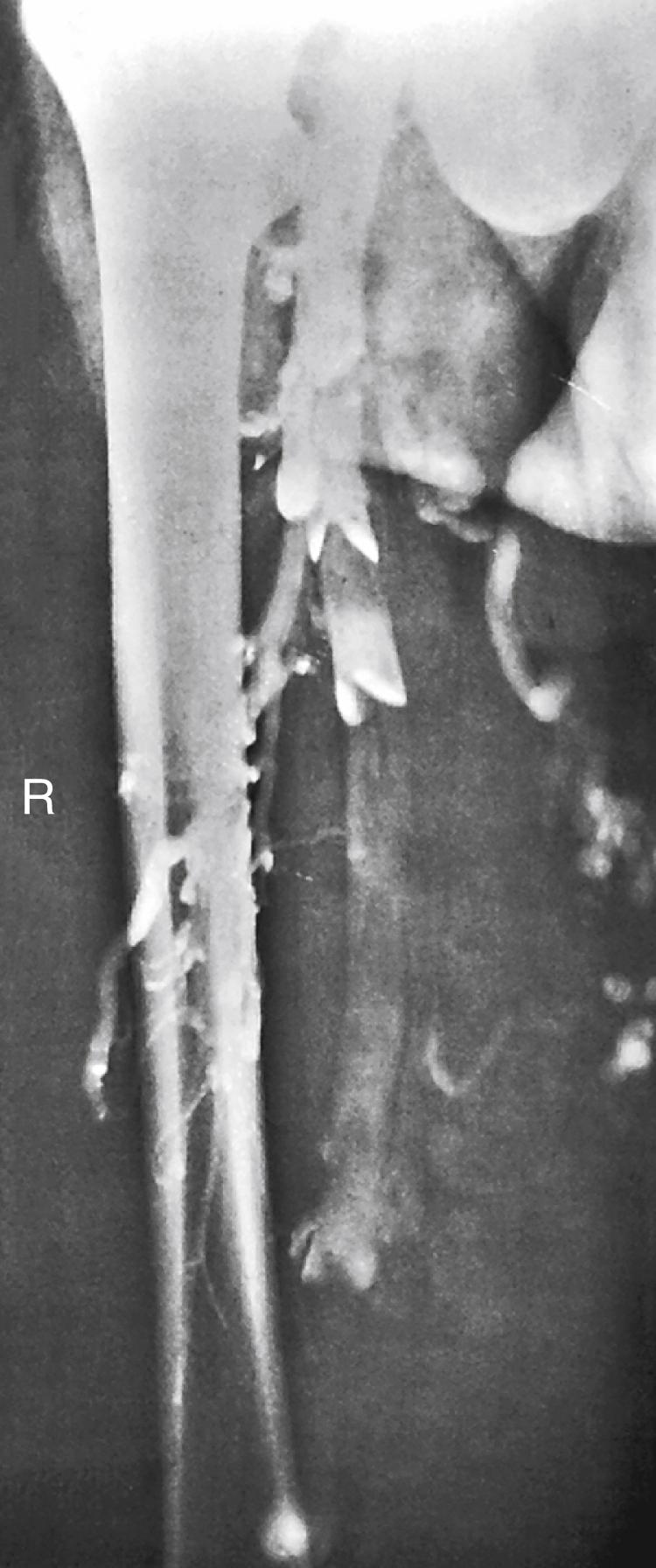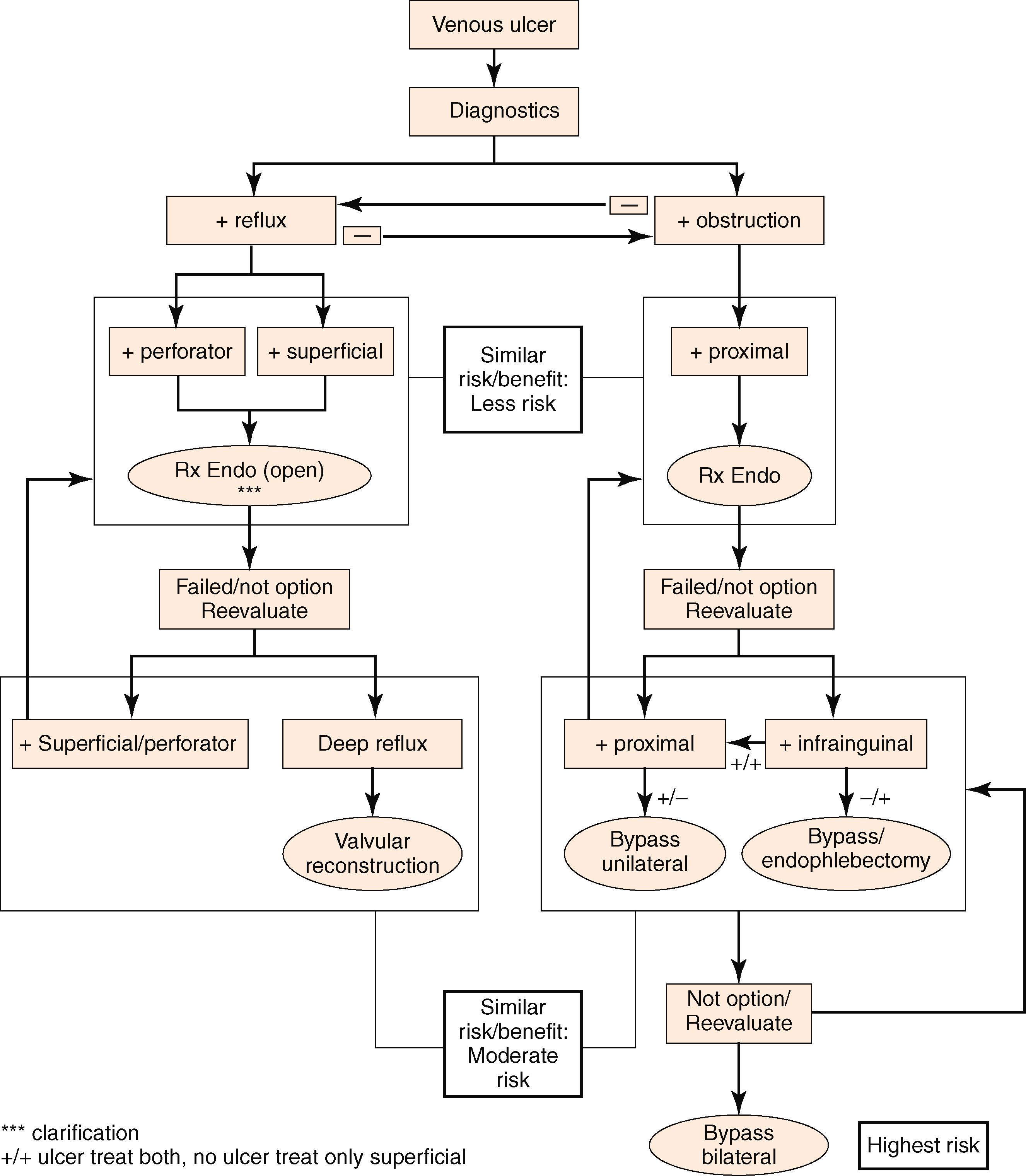Physical Address
304 North Cardinal St.
Dorchester Center, MA 02124
Using modern classification methods for lower extremity venous disease and considering the entire disease spectrum within given populations, roughly 15% of patients will have edema, 7% skin hyperpigmentation, 1.4% healed and 0.7% active venous ulcers. , Due to the technical challenges and increased risks of a venous valve repair in relation to less invasive treatments, essentially all other venous pathology is treated before deep venous reflux is addressed. Even then deep venous reflux is only treated at select centers and in those patients with truly disabling symptoms. Venous ulceration is the most distressing, disabling and costly for the patient and society; therefore, patients with venous ulcers are the most likely to be evaluated for venous valve repair. , The patient population that might benefit most from valve repair are those patients who have ulcer recurrence despite conservative therapy, which in compliant patients is ∼40% and in poorly compliant nearly 100%. , Following failure of conservative therapy, superficial and perforator insufficiency is generally eliminated by percutaneous ablation with ulcer recurrence in 30%–50% of cases. Correcting iliac venous obstruction without addressing deep venous insufficiency can result in long-term ulcer healing in 60%–80% of cases. , If the estimate of venous ulcer prevalence per year in the US population of 500,000 is correct and we assume the best outcome for each prior intervention (60% conservative treatment, 70% superficial ablation and 60% stenting success) that would still leave 24,000 patients per year who may benefit from deep vein valve repair to heal their ulcer. An even more conservative calculation arrived at nearly 5000 candidates in need of venous valve repair to aid ulcer healing. This would require at least 20 surgeons adept at deep vein valve reconstruction performing 250 operations yearly to meet the demand. In addition, if other symptoms are causing major disability, valve reconstruction might be a reasonable consideration.
The common femoral, profunda femoris, and femoral veins are covered by skin, soft tissue, and fascia in the groin and by the sartorius muscle more distally. Just proximal to the knee, the femoral vein occupies the adductor (Hunter’s) canal, which places it deep to the sartorius and flanked by the vastus medialis and adductor longus muscles. Distal to the adductor canal, the femoral vein becomes the popliteal vein and lies between the heads of the gastrocnemius muscle distally, but is covered only by skin, soft tissue, and fascia directly behind the knee. The anterior tibial veins lie in the anterior calf compartment, deep to the anterior tibialis muscle. The posterior tibial and peroneal veins lie in the deep posterior compartment and are covered by the soleus and gastrocnemius muscles, which form the superficial posterior compartment. Illustrations that can aid in visualizing the anatomy are available in the literature and should be referenced. , Each deep vein involved with a venous disorder is named in a complete CEAP classification, as reviewed in the most recent update to that system.
Venous valves are thin but very strong connective tissue structures with minimal muscular media covered by endothelium and generally bicuspid in design. Valves are universally present in the paired tibial and peroneal veins, with 3 to 12 valves evenly distributed in each vein. The majority of popliteal veins (>90%) have one to three valves, with a slight trend to be located more caudal in the leg. The femoral veins have one to five valves. , In about 90% of patients, the most constant valve location is in the proximal femoral vein 1 to 2 cm distal to its confluence with the profunda femoris vein. In 88% of patients, the profunda femoris vein has one to four valves. The common femoral vein, often thought to have no valves, actually has one or even two valves within a few centimeters of the inguinal ligament in 30%–50% of patients. Rarely does the external iliac vein have a valve (∼25%), and the common iliac vein lacks a valve in most cases.
The proper nomenclature for the etiology of deep venous insufficiency is found in the CEAP (Clinical/Etiologic/Anatomic/Pathologic) classification, which was recently updated by an American Venous Forum task force. , The most important factor for venous valve repair is the state of the valve leaflets; namely, whether they are architecturally preserved allowing primary repair by reefing techniques or whether they are absent or so damaged that they are beyond repair. Congenital absence of lower extremity venous valves, venous aplasia, or dysplasia as a cause of axial venous reflux is rare but can be seen in cases such as Klippel–Trenaunay syndrome or arterial venous malformations.
Much more common than congenital venous insufficiency is primary venous insufficiency. This can occur in patients with retained valve architecture but floppy, redundant, elongated valve cusps ( Fig. 159.1 ) and/or from defects in the vein wall that cause the valve ring to dilate. Either cause results in mal-approximation of valve cusps and reflux in the involved veins. Primary venous insufficiency is a degenerative condition which progresses over time and generally involves the deep veins late in the process. One explanation for deep venous insufficiency occurring after superficial insufficiency is called the “overload” theory: superficial venous incompetence results in recirculation of blood, increasing the volume of blood in the deep venous system and distending them until their valves no longer function properly. This explains why deep venous reflux may resolve after superficial vein ablation. , In some patients thought to have primary venous insufficiency, asymmetrical insertion or development of cusps may be only identifiable at the time of operation and thus represent an occult congenital defect.

Secondary venous insufficiency is defined as having an apparent pathology that caused valve damage. The pathology is often acute deep venous thrombosis (DVT), and may be the cause of 40% to 70% of the deep venous valvular incompetence. The resulting inflammation and scarring with recanalization can cause foreshortening and fibrosis of the valve leaflets, small perforations, or valve adhesion and luminal narrowing ( Fig. 159.2 ). The valves are so damaged that direct repair is not possible. Other potential intravenous and extravenous etiologies such as traumatic arteriovenous fistula or primary intravenous sarcoma may also cause secondary venous insufficiency. Options to repair axial reflux in these cases must involve construction of a competent valve: one can recruit a competent valve from another local system, transplant one from a distant site, or make a substitute valve.

The line between primary and secondary presentations can be blurred in some patients. In these cases both pathologies can be observed, either in diagnostic studies or during open surgical inspection. , Several theories have been proposed to explain a relatively normal valve within otherwise damaged vein. , Secondary etiologies other than DVT that can result in venous insufficiency with retained valve architecture include traumatic arteriovenous fistula or systemic issues such as prolonged congestive heart failure. Regardless of the reason for the observed changes, the critical issue is whether valve leaflets remain sufficiently intact to allow for direct repair that will render the valve competent.
The primary hemodynamic consequence of venous valve incompetence is reflux across the valve, particularly when standing. In general, the lower leg muscles push the blood toward the heart with each step, counteracting gravity to recirculate the blood. With enough incompetent valves present, this system of blood return becomes ineffective, resulting in sustained venous hypertension. This is most prominent at the microcirculatory level and is reflected in the signs/symptoms recognized as chronic venous insufficiency. In one series evaluating only venous ulcers, 73% had deep venous reflux with or without reflux in the superficial/perforator veins; the femoral/popliteal vein was the most commonly affected, and primary disease predominated. To realize the goal of controlling lower limb ambulatory venous hypertension, correction of deep axial reflux proximal to the calf is required. Because two deep venous pathways exist for blood in the thigh, an isolated femoral vein or profunda femoris vein valve reconstruction could result in clinical failure when prominent reflux remains in the other pathway. If one of the two is competent, providing a functional valve in the other can result in overall clinical success. , In some cases of complete femoral vein occlusion, there is tremendous dilation of the profunda femoris vein, such that only correction of reflux in it will lead to an improvement in venous hemodynamics. An alternative method of correcting significant axial reflux when both femoral systems are incompetent is to position a competent valve in the popliteal vein (sometimes called the gatekeeper position), to allow more normal venous pressures in the calf vein during exercise. At least one investigator has performed multiple tibial vein valve repairs to accomplish the same goal.
Patients with chronic venous disease due to deep venous incompetence can present with any of the CEAP clinical classifications, from C0 to C6, with or without associated symptoms. Physical examination and evaluation of venous reflux, including using a simple handheld Doppler unit, is considered the first step in a complete venous patient evaluation (level of investigation I in the CEAP system). , In those patients with an ulcer, an arterial pulse examination and measurement of ankle–brachial index are critical to rule out the presence of arterial occlusive disease (grade 1, level of evidence B). A careful history should take note of previous episodes of DVT, known hypercoagulable conditions, and any limitations in physical and occupational activity resulting from venous insufficiency. As importantly, the physical examination can eliminate other causes of the patient’s symptoms, such as ischemic ulcers, diabetic ulcers, dermatologic disorders, and even skin or soft tissue cancer; a more complete list is provided in SVS/AVF guidelines.
Each patient should ultimately be stratified according to the CEAP classification to clearly define the venous disease present, which will allow the formation of a focused and appropriate management strategy. Candidates for deep venous valvular reconstruction typically have class C4b to C6 disease, or disabling signs and symptoms such as severe edema (C3). The Venous Clinical Severity Score provides a quantification of disease severity and is a useful evaluation tool to determine a patient’s response to treatment. Quality-of-life instruments provide an estimation of the impact of venous disease on the patient’s life and the effect that therapy has on the patient’s overall well-being. Performance of these evaluations is considered a best practice; Societal guidelines give quality-of-life measures a grade 1 recommendation for all classes of venous disease and is considered critical to determining treatment success. ,
A complete venous duplex evaluation (see Ch. 25 , Vascular Laboratory: Venous Duplex Scanning) comprises the next major step in the evaluation of the patient with suspected deep venous disease (level of investigation II in the CEAP). , , Duplex evaluation is essential prior to any interventional procedure (grade 1/level of evidence A/B). , It clarifies the extent and anatomic location of all venous disease, provides an indication of the etiology (congenital, primary, or secondary), and aids in determining the pathophysiologic mechanism (reflux, obstruction, or both) of the disease present. The imaging is often so clear in primary deep venous incompetence that venous valve cusps can be seen moving in the venous stream. Insufficiency within any segment of the deep venous system is defined as a prolonged reflux time through the valve after a provocative test. The recommended cutoff value for abnormal reversed flow (reflux) is 1 second in the femoropopliteal veins and 500 milliseconds for the deep femoral and tibial veins. , Venous obstruction is seen as thickened, scarred, and constricted veins or valves with absent or poor flow and absent or diminished augmentation after distal or proximal compression. Respiratory variation can be lost because of local disease or proximal obstruction.
Plethysmography (see Ch. 24 , Vascular Laboratory: Venous Physiologic Assessment) can provide a method to quantify the impact of deep venous insufficiency prior to and after deep venous valvular reconstruction with some insight into treatment success. Plethysmography is used for specific indications in patients with advanced disease or as a research tool (grade 2, level of evidence B) and can be part of an investigation level II evaluation. , , , Air plethysmography provides a quantitative estimate of venous insufficiency in the form of venous filling index (abnormal >2 mL/s), while the residual volume fraction (abnormal >35%) has a linear correlation with ambulatory venous pressure measurements. The ejection fraction correlates with the efficiency of the calf muscle pump; a value of less than 60% is considered abnormal. The ability of the calf muscle to function well is a critical factor in the ultimate outcome of deep venous reconstruction. Some early work suggests that it might be useful in evaluating the influence of iliac vein occlusive disease.
For patients being readied for deep vein valve surgery, venography aids in precise operative planning if no other less invasive modality can provide the same detail. Ascending venography (see Ch. 28 , Venography) defines deep vein anatomy and eliminates or confirms obvious obstruction, thereby providing a means of selecting the most disease-free area for surgery; for example, when valve transplantation is comtemplated. , Ambulatory venous pressure with or without thigh tourniquet and venous reflux time can be measured, if desired, but is rarely used in current practice. , , The importance of significant iliac vein occlusive disease is determined best by the use of intravenous ultrasonography. Descending venography (see Ch. 28 , Venography) is used to determine valve leaflet integrity, anatomic location, and the extent/degree of reflux within the femoral, profunda femoris, popliteal, and tibial veins ( Fig. 159.3 ). It has challenges in accurately determining the presence of valvular incompetence in all cases and as such direct operative inspection remains the “gold standard”. However, the combination of venous duplex examination and descending venography provides the best available preoperative determination of valve architecture to date. Magnetic resonance imaging and computed tomography are generally used to evaluate occlusive venous disease rather than to provide evidence in the evaluation for valve repair. Each may be useful in detecting extrinsic compression, especially at the iliocaval level. These types of studies constitute those included in investigation level III of the CEAP classification and are generally reserved for those with more advanced/complicated venous disorders.

Evaluation of the patient with suspected venous disease should follow a standard protocol in clinical practice (CEAP). The patient’s examination (including handheld lower extremity venous Doppler investigation) and history confirms the presence of disease, the clinical classification (C of CEAP), and the potential etiology (E of CEAP). The addition of venous duplex imaging (with or without plethysmography) confirms the clinical impression; identifies the location of disease and the types of veins involved (superficial, perforator and/or deep, the A of CEAP); and indicates whether the underlying pathophysiology is due to reflux, obstruction, or both (P of CEAP). The investigation often stops at this point if superficial/perforator disease is the predominant pathology, and this disease is treated. If the patient has recurrent problems, a more in-depth investigation for proximal (iliofemoral) venous occlusive disease is undertaken with invasive imaging (venography with intravascular ultrasonography). Investigation has advanced to diagnostic level of investigation III with these studies. If occlusive disease is present and the symptoms are sufficiently severe, angioplasty and stenting of the affected outflow vein(s) is undertaken. If unsuccessful in relieving disabling patient symptoms and deep vein axial reflux is the major pathologic condition demonstrated by duplex imaging and descending venography, valvular reconstruction is advisable. As an example and in terms of a basic CEAP classification, the patient requiring an internal valvuloplasty to treat a symptomatic venous ulcer would be a C 6-S ;E p ;A d ;P r (Level 3; 4/1/2020) with a descending venogram performed on 4/1/2020.
Patients being considered for deep venous valvular repair have generally failed all other interventional therapy to resolve their symptoms. Societal guidelines suggest that in select patients with clinical class C4b, C5, and C6 disease; valve repair (internal valvuloplasty, external valvuloplasty, external banding), valve transposition or transplantation, and/or autogenous valve substitutes can aid in venous leg ulcer healing and prevent recurrence when added to standard compression therapy (grade 2, level of evidence C). An algorithm for the surgical care of patients with venous ulcers, which can be extrapolated to all those who might benefit from deep venous valve repair, is found in a pertinent societal guideline ( Fig. 159.4 ).

Patient risk assessment must follow the tenets of any open operative intervention. Hemodynamic instability from the operation is minimal, but because the operative intervention is time-consuming and technically challenging, general anesthesia is typically required. An acceptable cardiac and pulmonary status is required. Systemic infection should be treated before intervention. Other potential causes of venous hypertension such as obesity, heart failure, or external compression from tumors, for example, require treatment regardless of the underlying venous effects. The presence of systemic diseases that may impact healing, such as collagen vascular disease, diabetes, chronic renal insufficiency, or lower extremity arterial occlusive disease, is a relative contraindication to venous intervention unless these conditions are corrected or medically optimized first.
The treatment options to correct deep venous valvular insufficiency are determined by the availability of structurally intact venous valves, as documented by imaging or, in some cases, by direct surgical exploration. Selection of the operative technique when the valve cusps are preserved is determined by the degree of cusp prolapse and the surgeon’s preference/skills. In the case of valve prolapse secondary to limited vein wall dilation and often seen to normalize during vasospasm, decreasing the vein diameter may re-establish a competent valve. In such cases, external banding of the vein at the valve site may provide a workable solution to prevent reflux. With more extensive wall dilation and cusp prolapse, external valvuloplasty may more dependably decrease the wall diameter and allow some reefing of the valve cusps. Extensive valve leaflet prolapse and wall dilation is best treated with internal valvuloplasty that allows direct cusp leaflet shortening in addition to wall diameter reduction. Experience determines which method to use in each patient and, when in doubt, internal valvuloplasty provides the ultimate repair.
When there is no identifiable valve structure within an incompetent system, options are still available. If a parallel axial venous system has a competent valve, then a transposition procedure is possible. When this is not feasible, valve transplantation of a competent valve from a distant location remains an option. Alternatively, a valve can be made from autogenous pieces of vein sewn into the correct configuration. The delicate and technically demanding procedure of shaving the vein wall to fashion a valve is gaining support in the literature. Although most attempts at constructing a valve using synthetic components have failed, there remain a few options.
Multiple valve repairs in the same incompetent axial system (e.g., two or more in the femoral vein) may decrease the rate of recurrent reflux and thus symptoms. However, many surgeons have reported success when only one valve per incompetent system is repaired.
In the situation of architecturally intact incompetent valve(s) confirmed by preoperative imaging, most experienced surgeons choose the proximal femoral or profunda femoris vein for valvuloplasty when isolated disease exists or, when both systems are incompetent, repair both the proximal femoral and profunda femoris valves. This decision is based on the ease of exposure, proximity of the valves, familiarity with the approach, and size of the veins available for repair. When both the femoral and profunda femoris systems are incompetent, some have chosen to repair the popliteal vein valve, which is considered the “gatekeeper” to the lower leg venous system. , However, mid- or distal femoral vein valves can be repaired if they are surgically accessible and architecturally intact, and repair will accomplish the task of preventing distal reflux. As one proceeds more peripherally in the venous system, vein diameters and valve leaflets become smaller and thus more difficult to repair. Nevertheless, even tibial vein valves have been successfully repaired.
If a transposition operation is planned, appropriate imaging must have identified the presence of a competent valve (or one that can be repaired) in at least one axial venous system (femoral/profunda/great saphenous) to allow transposition of the incompetent system below the valve. Valve transplantation requires having identified an architecturally preserved competent valve in the axillary or brachial vein. The optimal place for implantation into the lower extremity is into the least damaged vein segment available, which will prevent axial reflux into the calf area. If transposition or transplantation is not an option, an autogenous alternative should be considered.
Selecting the optimal operative technique and location is based on the knowledge provided by preoperative imaging, expected long-term success, operative difficulty and risk/benefit ratio.
Become a Clinical Tree membership for Full access and enjoy Unlimited articles
If you are a member. Log in here